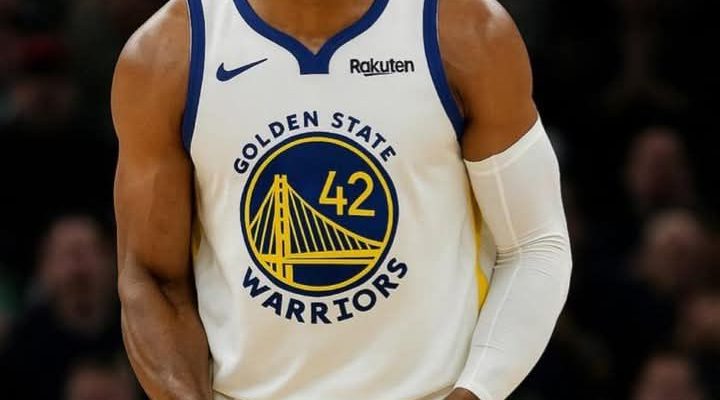The NBA offseason is always a time of intense speculation, strategic maneuvering, and careful calculation as teams attempt to assemble the best possible rosters for the upcoming campaign. This summer, one storyline that has captured the attention of fans and analysts alike revolves around veteran big man Al Horford and his expected signing with the Golden State Warriors. According to reliable insider Jake Fischer, the deal is anticipated to come with a player option for Horford, but both the Warriors and Horford’s camp are reportedly holding off on finalizing the agreement until the future of Jonathan Kuminga, one of Golden State’s young rising stars, becomes clearer.
This unfolding saga encapsulates many facets of how NBA teams build rosters in the modern era, balancing the value of experienced veterans with the growth and potential of younger players, all within the constraints of salary cap rules and long-term planning. To fully appreciate the significance of Horford’s expected signing and the implications surrounding Kuminga’s status, it’s essential to delve into the broader context: who Al Horford is as a player, the Warriors’ current roster dynamics, and what a player option entails from both the team’s and the player’s perspectives.
Al Horford is a seasoned NBA veteran known for his versatility, basketball IQ, and steady presence on both ends of the floor. Over the course of his career, he has built a reputation as a reliable big man who can contribute as a floor spacer, a passer, a defender, and a stabilizing locker room presence. Though no longer in the prime of his athleticism, Horford’s game has evolved to emphasize leadership, positioning, and fundamental skills, which allow him to remain effective even as younger players tend to dominate with raw athleticism. For the Warriors, a team that values high basketball IQ and team-oriented play, Horford’s skill set is a potentially perfect fit.
Golden State’s roster is currently a mix of superstars, experienced role players, and promising young talent. The team’s core, led by the likes of Stephen Curry, Klay Thompson, and Draymond Green, has championship pedigree and high expectations every season. Surrounding these stars is a group of complementary players who provide depth, defense, and shooting. The Warriors have also invested heavily in developing young players like Jonathan Kuminga, who was drafted with high hopes for his future contributions. Kuminga’s combination of size, athleticism, and skill gives the Warriors a unique asset for the future, but how he fits alongside veterans like Horford remains a critical question.
The notion that Horford’s signing is pending Kuminga’s status speaks to the team’s desire to maintain roster flexibility while maximizing their competitive window. If Kuminga stays with the Warriors, it may impact the minutes available for Horford and vice versa. Conversely, if Kuminga is traded, waived, or otherwise removed from the roster, Horford’s role might expand. This waiting game highlights the intricate chess match front offices play during free agency and roster construction, balancing short-term success with long-term development.
One crucial element in this situation is the inclusion of a player option in Horford’s anticipated contract. A player option gives the player the right to decide whether to remain with the team for an additional year at a predetermined salary or become a free agent again. This type of contract structure benefits players by offering them flexibility, allowing them to reassess their market value or playing situation after the first year. For the Warriors, offering a player option means committing to Horford without fully locking in for multiple seasons, thereby preserving cap space and roster flexibility should circumstances change.
From Horford’s perspective, a player option is appealing because it allows him to evaluate his fit with the team and his health after a season before making a longer commitment. For a veteran player, this flexibility is particularly valuable, given the physical toll of the NBA season and the uncertainty that can accompany age-related performance changes. Additionally, the player option can serve as a sign of mutual respect and trust between player and organization, signaling that both sides want to maintain options open without prematurely burning bridges.
The decision to wait for clarity on Kuminga’s future before finalizing Horford’s deal reveals the complex nature of roster management. Kuminga is still on his rookie contract, which is relatively inexpensive compared to veteran deals, but his potential means the Warriors may need to consider how to allocate playing time and developmental resources carefully. If the Warriors trade Kuminga or decide he doesn’t fit their long-term plans, Horford’s signing would fill a more prominent veteran role. If Kuminga remains, Horford’s minutes might be limited, and the team could explore shorter-term or more flexible options.
Moreover, the Warriors are operating in a highly competitive Western Conference environment where every roster move carries significant implications. Adding Horford could bolster their frontcourt depth, provide invaluable playoff experience, and improve their defensive and offensive schemes. His ability to pass from the high post and switch on defense complements Golden State’s style, which relies heavily on ball movement and switching on defense.
The veteran presence Horford brings can also have a ripple effect in the locker room. As a five-time NBA All-Star with championship experience of his own, Horford’s mentorship could be crucial for younger players like Kuminga, Moses Moody, or Jonathan’s teammate, helping them understand the nuances of playoff basketball and professional preparation. This intangible value often goes unnoticed in statistics but is vital in sustaining a culture of excellence.
Financially, the Warriors’ front office must navigate the luxury tax threshold carefully. Golden State has long been a team willing to pay the luxury tax to maintain a championship-caliber roster, but with the changing dynamics of the salary cap and collective bargaining agreements, each contract must be scrutinized. Offering Horford a deal with a player option is a prudent move that balances commitment with flexibility, allowing the team to adapt if circumstances around Kuminga or other roster pieces evolve unexpectedly.
It’s also worth considering how this situation fits into the broader NBA trend of teams increasingly valuing versatility and positional fluidity. Horford, though traditionally a big man, has the ability to stretch the floor and defend multiple positions, qualities highly prized in today’s game. The Warriors, known for their innovative and positionless basketball philosophy, can utilize Horford in various roles—whether as a floor spacer opening lanes for Curry and Thompson, a secondary playmaker facilitating ball movement, or a defensive anchor switching across positions. This flexibility makes Horford’s potential signing even more attractive.
Looking beyond just the roster construction, the wait-and-see approach regarding Kuminga could also be influenced by external market factors. The Warriors may be gauging interest from other teams in Kuminga as part of potential trade discussions that could reshape the roster. Front offices often engage in a delicate dance of timing, leveraging interest in young assets to improve the team while ensuring they don’t commit prematurely to contracts that could limit future moves.
Additionally, the presence of a player option might indicate that Horford himself is open to reassessing his career trajectory based on how well he meshes with the Warriors’ system and teammates. Veteran players often seek opportunities not just for financial gain but for a chance at championship contention and a meaningful role. The Warriors, with their established core and winning culture, represent an attractive destination.
The intrigue surrounding this signing also speaks to the ongoing narrative about veteran players’ roles in the league. While youth and athleticism dominate headlines, teams recognize the need for experienced players who can navigate high-pressure situations and provide stability. Horford embodies this duality—bringing both a high basketball IQ and the skill set to complement a star-studded lineup.
In summary, the expected signing of Al Horford by the Golden State Warriors, as reported by Jake Fischer, is a strategic move that reflects careful consideration of roster balance, financial prudence, and player development. The inclusion of a player option provides flexibility for both parties and aligns with the evolving needs of a team striving to compete at the highest level while nurturing young talent like Jonathan Kuminga. The fact that both sides are waiting to see what happens with Kuminga underscores the dynamic and interconnected nature of NBA roster construction, where one player’s future can significantly impact the plans for another.
As the offseason progresses, it will be fascinating to watch how this situation unfolds and how the Warriors ultimately position themselves for another run at an NBA title. Whether Kuminga remains or moves on, Horford’s addition, if it comes to fruition, could provide the Warriors with the veteran leadership, versatility, and basketball acumen necessary to navigate the challenges of the upcoming season. The decision-making process around this signing exemplifies the complexity and nuance of building a modern NBA roster—where timing, talent evaluation, and strategic flexibility all play critical roles in achieving success.



